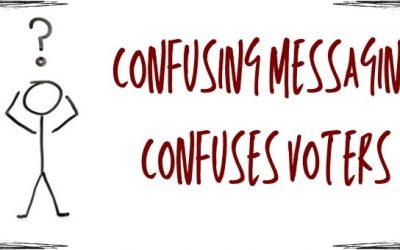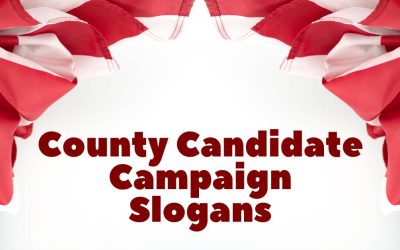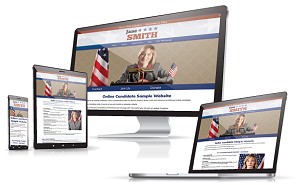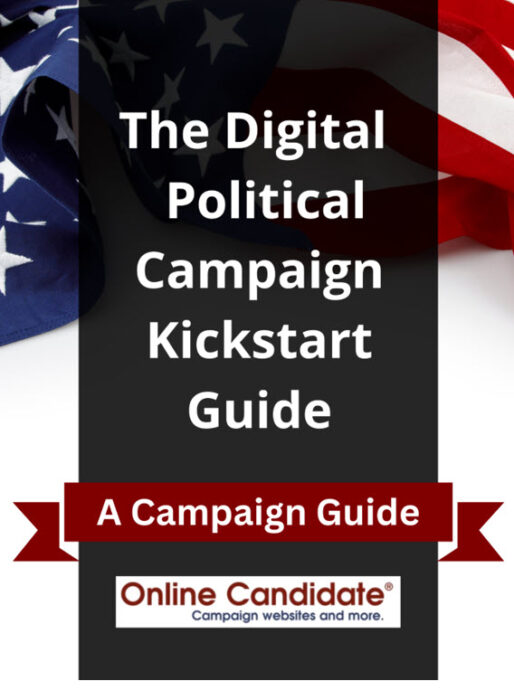Three Essential Political Website Disclaimers
All US jurisdictions have laws covering the use of disclosure statements on political advertising. Specific items that both require a political disclosure statement include billboards, bumper stickers, sample ballots, newspaper ads, TV and radio ads, magazines, mass mailings, pamphlets, fliers, palm cards, and even email.
Political campaigns must use a disclaimer for any public communications or political advertisement. Disclaimer requirements also apply if you are a:
- Candidate
- Political committee
- Election or campaign committee
- Political party
- Political action committee providing independent expenditures
The Federal Election Commission (FEC) defines public communications as “paid or unpaid announcements to the general public, such as advertisements, speeches, and articles printed in a newspaper.”
Here are other types of communication where a political disclaimer is required:
- Broadcast, cable or television ads
- Billboards
- Newspaper or magazine
- Mass mail and email
- Phone bank calls
- Online advertising, including social media and banner ads
- Other public campaign communications
Ballot measure and independent expenditure advertisements often require higher scrutiny under disclaimer rules. This is because, unlike political parties or a campaign committee, the public may not fully be aware of the organizations sponsoring those communications.
Political Disclaimer Types for Online Use
Online advertising communications
Facebook and Google both require verification of a candidate and committee before they allowed to advertise on their respective platforms.
You must also provide disclosure language in order to run online political advertising. Google and Facebook, for example, both require authorization of who is responsible for the advertising in addition to actual disclaimers in the advertisement.
For display ads, like those used in IP targeting, political advertisement rules require a readable notice as to what organization or committee made the expenditure on the ad graphic itself. Ads will get rejected if the disclaimer is too small and unreadable. In addition, information must be provided that identifies who paid for the ad, including a physical address, website address and the committee treasurer information.

A political ad disclaimer example.
Political Website Disclaimers
For political campaign websites, there are three standard disclaimers. Not only do they help you comply with the law, but they also help protect you legally.
Besides the “Paid for” disclaimer on your website footer, you should include the following disclaimers:
Authorization Disclosure
The specific wording required varies but it is usually some variant of candidate committee authorization. For example, “Paid for and Authorized by [the candidate or political group]“. Adding that text to a political website is simple, and most campaigns place this information near the bottom of each web page.
Your site should also feature a contact page that includes a full address, name and information about the political committee or sponsoring organization.
Privacy Policy
Most people don’t read ‘legalese’, but a good privacy policy helps build trust, particularly with potential donors. It’s best to be restrictive with your privacy policy and promise not to sell or share visitor information with anyone. This section can also cover users under a particular age, typically age 13. The stronger your privacy policies, the better. Spell them out in a plain sentence or two, followed by more detailed information.
Terms of Use
Sometimes these are lumped together with the privacy policy. Other times they are broken out. Your terms of use may cover a variety of situations. Political campaigns will want to be sure to address the following:
- Language that the site materials are provided ‘as-is’.
- Limitations: Limiting liability for any user damages from use of the site.
- Revisions: Disclaimer language that the material on the site may not be accurate, and that the organization accepts no liability for inaccurate information.
- Links: That you are not liable for any content on outside websites, and that there is no endorsement implied to outside content.
- Governing law: Of the appropriate state.
If you are unsure of what to add for your political campaign policies, look at another site’s policy as a template, but be sure to modify it fully for your needs. In other words, don’t copy a policy from an online retailer; it will look pretty silly if your page include information about product returns and call center hours.
Online Candidate websites include places for you to easily add your disclaimers – along with sample copy. Find out which website package is best for you.
A List of Our Best Judicial Campaign Slogans
As a candidate running for judge, you’ll want to stand out from your opposition. Good judicial campaign slogans help keep you in the minds of voters.
As a judge, you will take an active role in your community. You will have a hand in the legal policies and issues that effect citizens and residents of your city and state. Since judges cannot run on political issues, your election slogan should reflect your personal judicial priorities.
Here is a list of our best slogan ideas for judges:
- Integrity. Honesty. Commitment.
- Hardworking, Experienced, Fair
- A Justice for YOU
- The right experience, the right choice
- A Judge for the People
- Justice with Integrity
- Justice with Compassion
- Experience You Can Count On
- Proven Experience
- Balanced, Fair, Firm
- Justice from the Bench
- Working for Justice
- Putting the Law First
- Principled and Effective
- Hard Work Makes the Difference
- Tough on Crime, Fair in Justice
- Family Focused
- Qualified and Competent
- Honorable, Fair, Committed
- Comment Sense – For the Bench
- Probate Matters are Family Matters
- Impartiality and Equality in the Courtroom
“I am the Law!” If you don’t get this reference, look it up!
Voters don’t often pay attention to judicial elections. On Election Day, they may not even know who the candidates are on the ballot. Despite their crucial role, voter turnout in judicial elections is typically low. Most won’t ever interact with a candidate unless they end up before them in a courtroom in the future.

Start your judicial campaign website today with Online Candidate. Get a professional-looking site in days, not weeks.
Related Posts:
Confusing Messaging Only Confuses Voters
The old KISS principle means keep it simple, stupid. It basically means that things work best if they are kept simple rather than complicated.
The principle works in design. It works in systems. And the KISS principle works in politics.
A winning campaign message resonates with voters. Successful politicians boil their messaging down to the most basic elements.
There may be several important issues facing your district. It doesn’t matter if it’s economic situations, social policies, or how the local government is managed.
Your primary focus should be on issues that a majority of voters feel strongly about. If there is a specific problem or two that frustrates voters of all types, then those are the issues you should narrow in on. You may have a lot of ideas for your community, but if you try to explain everything you want to do to voters, you will not be able to hold their attention.
Your messaging needs to be on point. Boil down each problem to its’ essence. You may even be able to translate a relevant issue into a single sentence, phrase, or even a slogan.
But that solves only half the problem. Your solutions need to be equally elegant. Narrow down your fixes to a few specific points per issue. Make those points address the pain or frustration that your voter experiences. Show them what distinguishes you from your opponent.
“The single biggest problem in communication is the illusion that it has taken place.” – George Bernard Shaw
In reality, issues and answers are far more complex and nuanced. You may have detailed outlines that address a variety of issues. Save those complicated plans for elsewhere. Keep them away from your campaign material.
When communicating with voters, maintain the KISS principle. You can only maintain a voter’s attention by being simple and direct. Even if your topic or solution is complicated, figure out a way to make it easy to understand.
Avoid using weak terms like “vision,” “pledge,” or “optimism” that sound good but mean little. Your words should be specific enough to describe your desire and plans for change.
Offer a clear promise of what you plan to accomplish in office. If you get lost in detail and minutia, you will lose a voter’s attention.
In your campaign literature and website, you should:
- Explain your primary issues and solutions clearly.
- Use subheadings and bullet points.
- Use pull quotes that distill your positions and solutions.
Sometimes we see clients turn the issue pages of their candidate website into a massive, detail-laden policy creeds. We’ve seen clients who put a tremendous amount work writing out every aspect of their issues, their reasoning, and what they plan to do. Often this reads more as stream-of-consciousnesses than a real political platform.
While you don’t have space limitations online, if you write too much, most voters will see a wall of text and simply move on. Make you content easily understood and digestible with short paragraphs, bullet points, and clear sections. Use the opportunity to tell a story that interests and engages voters. This principle also applies to your print material.
Make your message about the voters and what you, as an elected candidate, can do for them. Confusing communication damages the credibility of both the candidate and their campaign.
Keep it simple, and voters will know exactly where you stand.
That’s how effective candidates win elections!
Sheriff Campaign Logo Design
As you begin to brand your campaign, your sheriff logo should be designed so that it is recognizable at first glance by potential voters. It should embody the values and ideals of a sheriff, who is in charge of upholding justice for the community.
Our custom political website packages include a professional logo design. Why spend a lot of money on a professional designer? Or a logo builder that charges you for a decent quality version?
Regardless of who designs your logo, you’ll need a high-resolution file. Web graphics are created in low resolution, but for brochures or signs, you’ll need to use files that are of higher quality. We provide our clients with graphics that are optimized for high-quality printing in a range of formats including SVG, PDF and JPEGs. This helps keep your branding consistent.
We also have a good idea of what can and cannot appear on sheriff candidate websites and print material. For example, some municipalities forbid candidates from wearing a official sheriff badge or a law enforcement uniform in political material. If we suspect an issue while we are creating your graphics, we’ll let you know.
Sample sheriff candidate logos



See other sample sheriff logos.
Law enforcement and sheriff logo design tips
Here is information about what design elements are in sheriff insignias, how to use them, and the importance of these elements in designing your own logo.
- Blocky fonts work best. The typeface should be bold and easy to read. Many candidates for sheriff or any law enforcement position tend to use a serif font. Script lettering can be hard to read and don’t translate well for print.
- Use stark colors. Law enforcement often have adopts a black-and-white or blue-and-black color scheme, often adding their own logos on the cars and uniforms to make themselves easily recognizable. Some sheriff departments have adopted different color schemes, such as red or yellow for their uniforms, but they are yet to be widely adopted.
- Stars and badges. Incorporating a badge graphic or shield into a sheriff logo is standard, and for good reason; It immediately tells the voter the position the candidate is running for. These design elements are often shaped in shield or circle. Other design elements include eagles and the iconic “Old West” badge.
Downloadable sheriff campaign logo templates
Don’t need a website? We carry a large number of sheriff logo templates for both Adobe Photoshop and Canva. Either a free Canva account or Adobe graphic software is required, depending on the template purchased. We also offer graphic design services.
Our Custom Sheriff Website Packages includes a free custom logo design and header. We’ll also provide high-res versions for your print material. Why pay hundreds of dollars to have a designer just create a logo? We’ll make one for you – and it’s included with your website.
Related:
A List of Our Best County Candidate Campaign Slogans
Here is a list of some of our favorite slogans for county office:
- Leadership for a Stronger County.
- Unity, Vision, Progress: Your Choice for County Executive.
- Building a Better Future for Our County Together.
- Dedicated to Our Community, Committed to Change.
- Driving Progress with Integrity and Innovation.
- Voice for the People, Vision for the Future.
- Transforming Challenges into Opportunities for Our County.
- Responsive Leadership, Resilient Community.
- Empowering Our Community, Enhancing Our Future.
- Committed to Excellence in County Governance.
- A New Direction for Our County.
- Together, We Can Build a Brighter Future.
- Leadership That Listens, Action That Delivers.
- For a Thriving, Sustainable Community.
- Your Advocate for a Better County.
- Innovative Solutions for Complex Challenges.
- Transparency, Accountability, Results.
- A Stronger County Starts Here.
- Championing Growth, Ensuring Stability.
- Building on Success, Focusing on the Future.
- Uniting Our Community with Purpose and Passion.
- Forward Thinking, Community Leading.
- From Vision to Action for Our County.
- Investing in Our County, Inspiring Our People.
- Dedication to Development, Commitment to Care.
- Elevating Our County, Empowering Our People.
- Progress with Purpose.
- Together for a Stronger, Safer County.
- A Record of Results, A Vision for Tomorrow.
- Making Our County a Better Place for All.
- Responsive, Responsible Leadership.
- Your Choice for Positive Change.
- Bold Vision, Real Solutions.
- Serving with Integrity, Leading by Example.
- Prosperity Through Partnership.
- Creating Opportunities, Celebrating Our Community.
- Driven by Community, Focused on Results.
- A Better County for Everyone.
- Real Leadership for Real Challenges.
- United for Our County’s Future.
- Innovate, Integrate, Inspire.
- Your County, Your Future, Our Commitment.
- Leadership with a Heart for Our Community.
- A Plan for Progress, A Path to Success.
- Shaping Our County’s Future Together.
Related Posts
- So You Want To Run For County Office? Here’s How To Get Started
- A List of Our Best County Candidate Campaign Slogans
- County Campaign Websites
Start your campaign website with Online Candidate. We’ve got the expertise, the resources, and the affordability you need to win. Contact us today to get started!
Political IP Targeting Strategies for Your Campaign
With candidates these days having limited options in reaching out to voters, IP Targeting offers a solution to directly reach specific households online. If you are wondering, “What is political IP targeting?”, it is a form of advertising that allows candidates and campaigns to directly target online ads to mobile devices and computers at an individual household level.
IP Targeting allows political advertisers to be very specific with who they reach – and at a fraction of the cost of many other advertising methods. The idea is that your ads appear on all devices – home computers, tablets, cell phones – that someone uses to view news sites, email portals and other popular sites across the web.
There are other benefits with IP advertising. They include cost-effectiveness, control over where your ads are shown, customization of how your ads will appear, targeting multiple demographics and geographic locations, and the ability to manage and schedule your online advertising.
Unlike radio or television advertising, IP Targeting works best when it is used selectively. Putting the right message before the right voter can be very persuasive. It helps to create a plan of who you want to reach, combined with the message you want to present.
Perfect to get out the vote for primaries and special elections. Political campaign advertising to regular voters helps improve turnout on Election Day.
Listen to this post:
How does political IP targeting work?
- Think of IP Targeting like political digital direct mail. Your ads can display on devices within a particular household. Your ads appear on websites through large online ad networks. Your ads are included as part of the inventory those networks display. For example, your ads can appear on news sites, email portals and other websites that carry online ads.
- You can precisely target voters. IP marketing uses individual IP addresses to target specific households. Your digital ads reach exact targets. It is more efficient than advertising that blankets an area. Hundreds of political campaigns across the country use this technology every election cycle. Most candidates target specific segments of their voter list.
- How much does IP marketing cost? IP ads are based on a CPM model, or cost per thousand impressions. This means the ads are charged per every thousand impressions (view on a screen). For example, with a $25 CPM, one thousand ad impressions costs $25. (View our IP pricing calculator.)
Like most advertising for a political campaign, IP targeting is best used for branding. The more of your ads voters see, the more effective they become. We recommend an exposure of at least a level of 20 impressions per household. And if you set a level that low, we recommend compressing the time frame of your ad campaign to a week or so.

Sample ad creatives used in political IP marketing campaigns
Online ads vary in size, and you’ll want your own display ads to match those sizes so they appear in as many places as possible. We recommend that clients have a creative (a banner) in each major ad size to maximize available ad inventory. While you can run ad campaigns with fewer sizes, it may limit your overall exposure.

Example of 250×300 pixel IP Marketing ad.
Typical ad sizes include:
- 300×250 (pixels)
- 336×280 (pixels)
- 728×90 (pixels)
- 320×50 (pixels)
- 160×600 (pixels)
- 300×50 (pixels)
Political IP marketing campaigns are typically run for two reasons. The first is to build marketing awareness to a specific voter audience. This may be used in conjunction with a mailing, so the recipients see both a print and online message. The second reason is typically for getting out the vote efforts.
Consider running targeted ads during these times:
- Before a primary
- At the start of early voting
- Just before a major mail drop
- Before a candidate canvasses for more constituent recognition
- As part of your get out the vote messaging.
There are a few requirements for running political display ads. Some form of identification and disclaimer must be visible (and readable) on each advertisement. This can be your logo and the name of your organization. We make sure your ad designs are compliant.
If you’ve advertised a campaign on Facebook, you’ll find the requirements for IP targeting to be a lot less stringent.
Strategies for creating advertising audiences from your voter list

Sample political IP Targeting display ad.
By Party: This is the most common way for political campaigns to determine who they want to reach through their IP Targeting. They take a district voter list, narrow it to voters of their own party, and target those addresses. Besides just targeting voters of a party, we recommend targeting active voters. This can mean people who voted in 2 of the last 3 primaries, 3 of the last 4 general elections, etc…
By Location: Why should everyone in your district get the same messaging? Perhaps the ads in one location should highlight something different than other areas. Because IP Targeting is based on addresses, it’s simple to parse locations by towns, zip codes or counties. If you have a campaign message you want to send to a specific location, it’s easy to segment your audience.
By Event: This applies mainly ‘Get Out The Vote’ messaging. This could be for primary day, the general election – or even when mail-in voting begins. We recommend targeting active voters for this sort of messaging. Considering the relatively low level of general voting participation, it makes sense to focus on those who will actually make it to the polls (or mail in a ballot).
By Issue: With the right voter or demographic data, you can determine what issues are important to what households. When shown to the right audience, issue-specific ads can perform very well in getting attention and clicks.
By Donor List: Just as businesses can target previous customer addresses, political campaigns can target previous donors. This would be the one case where you might want to look for a particular ROI (return on investment) on an ad campaign, rather than the amount of exposure generated.
By a Combination of the Above: One way to further develop a campaign is to segment your targets through multiple criteria. For example, you may want to target households of a single party in a particular location that are receptive to a particular issue. For example, you could promote your position on a regional issue specifically to households in an area effected by that issue.
Rather than generic messaging, like ‘Vote for” ads, targeted and focused political advertising gets more attention. Consider creating multiple, smaller ad campaigns targeting specific audiences with specific messaging. If you want to break through the clutter of state and national political advertising, you want to make your message as relevant to your audience as possible.
In many down-ballot races, a lot of undecided voters lean toward the candidate that they have been most exposed to. Appearing on a voter’s mobile and computer screens will get you noticed. The precision and cost of IP advertising offers several advantages over print, radio, or television advertising. When combined with other advertising mediums (like print), you’ll increase your overall exposure.
Interested in IP Targeting for your political campaign? We offer competitive rates and full creative design. We can help you create a strategy to effectively reach your voters.














